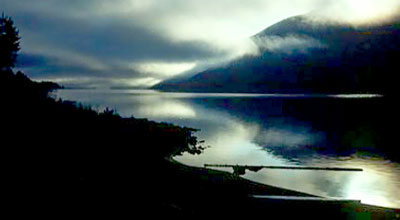Weather
 Lake, mountains, clouds, and forests.
Lake, mountains, clouds, and forests.
The moods of the Lake are largely a reaction to the weather. Variations in the water level—from vernal floods, to seiches, through eolian waves, and cat’s paw prints—are all weather driven. Whether pelted by hail or caressed by steam fog, the Lake dances to a tune played by the weather.
And, on an even deeper level, the very presence of the Lake owns much to the fact that it drains a large region of the interior wet belt. The rather substantial precipitation in the region is a fact of the weather, but that weather is a reaction of the winds to the Columbia Mountains (Monashees, Selkirks, Purcells, Cariboos), within which the Lake sits.
Organization Standard elementary treatments of clouds follow an old scheme based upon altitude: high, middle, low. The organization here is based upon the physical processes causing the clouds. This provides more understanding of what is seen.
My enjoyment of the Lake is inextricably bound to the weather. This section will explore some of the interactions; more will be added anon.
 steam fog, over the Lake evanescent sprites and devils
steam fog, over the Lake evanescent sprites and devils
 steam fog, over the land steaming fields and mountains
steam fog, over the land steaming fields and mountains
 advection fog a veil of white
advection fog a veil of white
 stratus and valley fog
stratus and valley fog
 wave clouds along with cap clouds, billows, pileus, and smoking mountain
wave clouds along with cap clouds, billows, pileus, and smoking mountain
 cumulus clouds a vigourously growing cloud of summertime
cumulus clouds a vigourously growing cloud of summertime
 thunderstorms the storm cloud of summertime
thunderstorms the storm cloud of summertime
 cirrus locks of hair aloft
cirrus locks of hair aloft
 snow level, rime and virga a November mountainside
snow level, rime and virga a November mountainside
 meteorological miscellany a grab bag
meteorological miscellany a grab bag
 interior wet belt region is relatively wet
interior wet belt region is relatively wet
 condensation water vapour into droplets
condensation water vapour into droplets
Weather’s delightful light shows—rainbows, haloes, coronae, shadows, shines, mirages—are treated in the section entitled, the play of light. Also, some climatology is presented on numbers.
![]()